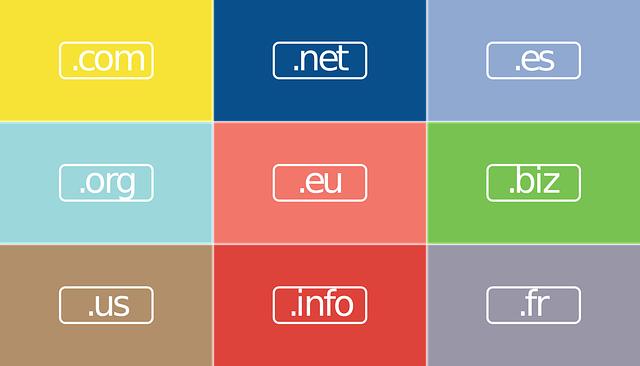Table of Contents
- Understanding the Domain Name Market Landscape
- Identifying High-Potential Domains for Flipping
- Effective Strategies for Marketing Your Domain Names
- Navigating the Sales Process and Negotiation Tactics
- Maximizing Profits: Timing and Pricing Your Domains
- Q&A
- In Retrospect


Understanding the Domain Name Market Landscape
In today’s digital age, the domain name market has evolved into a dynamic landscape filled with opportunities for savvy investors and entrepreneurs. The increasing value of identifiable and meaningful domain names has sparked a surge in interest amongst both new and seasoned domain investors. With the rapid expansion of online businesses, the demand for premium domain names that can enhance brand visibility and credibility has never been higher. Consequently, factors such as branding potential, keyword relevance, and market trends are pivotal in determining a domain’s value.
Understanding the various types of domain names can help investors navigate this competitive marketplace. Here are some important categories to consider:
- Brandable Domains: Unique names that are easy to pronounce and remember, often leading to higher resale values.
- Keyword Domains: Domains that include popular search terms can attract organic traffic and are often sought after by SEO-focused buyers.
- Expired Domains: Previously owned domains that become available again after the owner fails to renew them, often possessing existing traffic and backlinks.
- ccTLDs: Country code top-level domains that can increase the appeal of a site within specific geographic locations.
Additionally, financial literacy in the domain market is essential for recognizing investment opportunities. Here’s a simple breakdown of potential costs and expenses associated with flipping domain names:
| Expense Type | Estimated Cost |
|---|---|
| Initial Purchase Price | $10 – $10,000+ |
| Renewal Fees | $10 – $50/year |
| Broker Fees | 10% – 20% of sale price |
| Transfer Fees | Variable, typically <$10 |
By maintaining an awareness of market trends and understanding the nuances of domain valuation, investors can effectively identify and capitalize on lucrative opportunities in the domain flipping arena. As more individuals look to establish an online presence, the potential for even modest investments to yield significant returns continues to grow.
Identifying High-Potential Domains for Flipping
When it comes to flipping domain names, the key to success lies in identifying domains with high potential value. A few characteristics can significantly enhance a domain’s desirability, making it more than just a web address. Pay attention to domains that are short and memorable, ideally possessing one or two keywords that cater to popular markets or niches. For instance, a domain name that resonates with trending technologies or evergreen topics such as health, finance, or travel can attract potential buyers eager to invest.
Another critical aspect is the domain’s age and history. Older domains are often favored due to their established presence, which can contribute to higher SEO rankings. Tools like the Wayback Machine can help you dive into a domain’s past, revealing its former uses and any existing backlinks. Domains with a clean or positive history free from spam can be particularly enticing to buyers seeking to maintain or enhance online reputation.
Lastly, consider the extension of the domain. While .com still reigns supreme, other extensions such as .net, .io, or niche-specific extensions can have their own value depending on the target audience and purpose. Investigating current market trends can provide insight into which extensions are gaining traction. Keep a close watch on trending keywords and emerging industries that can provide fruitful opportunities for future domain investments.


Effective Strategies for Marketing Your Domain Names
When diving into the world of domain name flipping, having a solid marketing strategy is essential for maximizing profits. One effective approach is to leverage social media platforms. Utilize the vast networks of Facebook, Twitter, and LinkedIn to build a presence and connect with potential buyers. Create engaging posts that showcase your premium domain names, highlighting their potential uses and benefits. Regularly interacting with your audience by answering questions can build trust and spark interest in your offerings.
Another powerful tactic is to create a dedicated website or landing page that exhibits your domain portfolio. This allows you to highlight the unique features of each domain with compelling visuals and descriptions. Consider including a blog to cover trends in the industry, tips for new buyers, or insights into the value of certain keyword domains. Additionally, search engine optimization (SEO) plays a critical role; by optimizing your website for search engines, you can attract organic traffic and increase visibility among potential buyers actively searching for domains.
Don’t forget about the power of email marketing as a direct line to interested buyers. Building an email list comprised of domain investors and entrepreneurs can provide a targeted approach. Regular newsletters featuring your latest domain acquisitions, special promotions, and insightful content can keep your audience engaged. Here’s a simple table to help visualize the various marketing strategies:
| Strategy | Benefits |
|---|---|
| Social Media Promotion | Wide audience reach, engagement, community building |
| Dedicated Website | Portfolio showcase, increased SEO, content marketing |
| Email Marketing | Direct communication, target audience, higher conversion rates |


Navigating the Sales Process and Negotiation Tactics
Successfully flipping domain names not only requires an eye for valuable domains but also a strategic approach to the sales process. Begin by conducting thorough market research to identify what potential buyers are looking for. Consider factors such as keywords, length, and market trends. Domains that resonate with a current trend or industry can significantly increase their marketability. Utilize tools like Google Trends and keyword planners to find domains with desirable attributes that are in demand among businesses.
When you’re ready to list your domain for sale, crafting an engaging description is crucial. Highlight the benefits of the domain using key selling points, such as the potential for brand recognition. Use persuasive language that emphasizes the investment aspect of the purchase. Here’s a quick checklist for your domain listing:
- Clear and concise domain name
- Market relevance
- SEO potential
- Brandability and memorability
- Past traffic statistics, if available
Negotiating the sale can be a delicate dance. Establish your asking price based on the research you’ve conducted and be prepared to defend it. Consider the psychology of the buyer; they may initially offer less to gauge your flexibility. Be open to discussion but maintain your bottom line to ensure you don’t undervalue your asset. Having a negotiation strategy—such as knowing the maximum discount you can offer—can help you close the deal effectively. Moreover, closing tools like contracts or escrow services ensure that transactions proceed smoothly and securely, fostering a trustworthy relationship with the buyer.


Maximizing Profits: Timing and Pricing Your Domains
When it comes to profiting from flipping domain names, understanding the delicate balance of timing and pricing is essential. The domain market often resembles the stock market, with fluctuations influenced by trends, technological advancements, and even cultural happenings. To capitalize effectively, you should keep an eye on factors such as:
- Market Demand: Identify emerging trends before they peak to acquire domains that will soon see increased interest.
- Seasonal Opportunities: Certain keywords or industries may attract higher traffic during specific seasons or events.
- Competitor Analysis: Monitor competitors’ acquisitions and sales to anticipate market shifts and adjust your strategy accordingly.
Pricing a domain is an art that requires a mix of intuition and research. Start by evaluating your domain name’s intrinsic value based on criteria such as length, keyword relevance, and overall marketability. Utilize domain appraisal tools to get a sense of an appropriate price range, but don’t forget to consider the emotional value for potential buyers. Here are some tips for setting your prices:
- Comparison Shopping: Investigate similar domain sales to understand what buyers are willing to pay.
- Negotiation Flexibility: Set a slightly higher asking price to allow for negotiation without undervaluing your asset.
- List Versatility: Explore various platforms, from auction sites to marketplaces, and tailor your pricing strategy to each platform’s audience.
Consider implementing a pricing table to clearly represent various domains for sale along with their features and prices, making it user-friendly for potential buyers. A structured layout not only enhances readability but also emphasizes the value of each domain. Below is an example of how you can present your domains:
| Domain Name | Price | Est. Traffic |
|---|---|---|
| BestCookingRecipes.com | $2,500 | 1,000/mo |
| EcoFriendlyProducts.net | $1,800 | 800/mo |
| HealthAndFitnessGuru.com | $3,200 | 1,500/mo |
By thoughtfully considering timing and pricing, you’ll be well-positioned to maximize your profits in the domain flipping arena. Balancing market dynamics with strategic pricing can turn each flipped domain into a lucrative opportunity.

